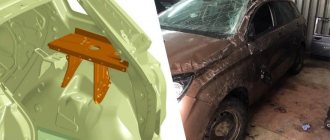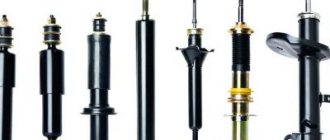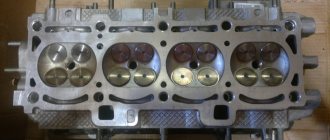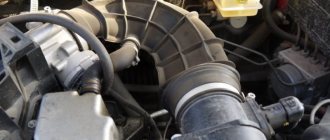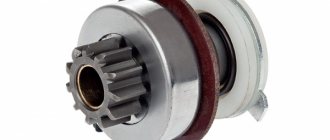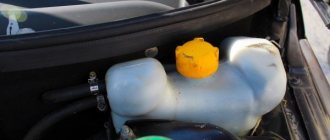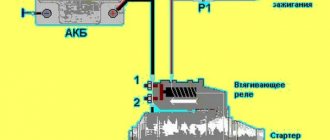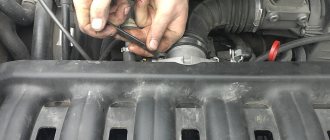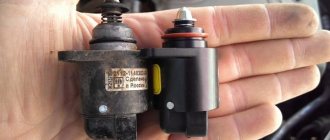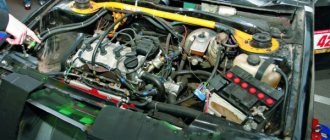“Trippling” of the VAZ-2109 engine is a term denoting a malfunction of the power plant that occurred as a result of failure and interruptions in the operation of one of the cylinders. This breakdown is quite common and occurs in engines with both carburetor and injection power systems.
Signs
“Tripling” appears on the VAZ-2109 in the form of:
- Unstable motor operation.
- Strong vibration.
- Power drops.
- Difficulty starting.
- The appearance of “pops” in the exhaust system.
“Tripping” is not a critical engine failure, and the car can be driven, at least to get to the repair site. But you shouldn’t delay repairs, since improper operation of one of the engine cylinders will ultimately lead to serious problems.
What to do if the engine starts to stall
For most car owners who do not have a specialized technical education, the reason why the car stalls and stalls seems strange and incomprehensible. However, even a novice auto mechanic knows that this is only an external manifestation of engine defects. Therefore, at the first signs of tripping, carry out diagnostics, but if you do not know how to do this, or you do not have the required equipment, contact the nearest, or better yet, a trusted car service center. An experienced mechanic will determine the cause in 5-10 minutes, after which he will offer solutions to the problem.
Pay attention when tripping appears. If this happens with a cold engine, and after warming up normal operation is restored, then there is a chance to get by with “little loss,” that is, minor and inexpensive repairs. The same situation occurs when idling is unstable; often it is enough to adjust the engine and its systems, after which the tripping will disappear.
Identification of an idle cylinder
The method for identifying a bad cylinder depends on the type of engine power system.
In carburetor engines, the determination of a failed cylinder is carried out experimentally. The essence of the method is to turn off each cylinder one by one by removing the tip of the high-voltage wire from the spark plug while the unit is running.
The check should begin with the 1st cylinder on a warm engine and with the speed set at 1500 rpm. If, after removing the tip, the speed drops significantly (the engine stops altogether, since as a result 2 cylinders will be switched off), the 1st cylinder is working normally.
Next, the test is carried out on the following cylinders. If the cylinder is not running, removing the tip will not affect the operation of the motor. After turning off the “drawdown” there will be no revolutions.
This test method is simple and allows you to accurately determine which cylinder is not working. But when doing it, follow safety precautions. High-voltage wires carry electrical impulses with high voltage but low current. These impulses will not cause damage to health, but the sensations are not pleasant.
As for the VAZ-2109 engine with an injector, the experimental method should not be used here (so as not to affect the operation of electronic systems). On such engines, the determination of an inoperative cylinder is carried out by scanning the ECU for errors. Interruptions in the operation of the motor are monitored by electronic systems and recorded in the form of error codes, by deciphering which we find out what caused the disruption of the normal functioning of the unit.
Video: VAZ-2109. The engine is shaking!
Why does a cold VAZ 2109 carburetor troit?
- Registration
- Entrance
- To the beginning of the forum
- Forum Rules
- Old design
- FAQ
- Search
- Users
We have a VAZ 21093 91 onwards. , carburetor—real mileage is unknown, but the speedometer shows 91,000 km. Malfunctions of the following nature: 1) When starting in the morning, the engine runs steadily for 10-15 seconds, after which it begins to fluctuate - obvious misfires are heard in the muffler - the engine jerks. As it warms up, the gaps become smaller and smaller - when it warms up to 50 degrees, the machine begins to work smoothly, but rare and small gaps are still sometimes observed. 2) The engine, it seems to me, does not have sufficient throttle response (I compare the sensations with the previous car 2105). 3) Slightly increased gasoline consumption in the city is 11-12 liters, and on the highway it is normal 7-8 liters.
What was repaired: 1) Replacing valve stem seals (due to high oil consumption) 2) Adjusting valves (before adjustment, the engine was quieter) 3) Repairing and adjusting the carburetor (the thread for the idle valve was broken, the power mode diaphragm was torn) 4) Rebuilt ignition distributor (weights did not return to normal state under the action of springs) 5) Spark plugs, wires, distributor cover, slider were replaced. 6) Replaced vacuum brake booster
All this led to improvements in engine performance, but the faults listed at the beginning remained.
Additional information: 1) The spark plugs look like they are running on a lean mixture 2) The quality screw for normal engine operation is unscrewed by 7 turns 3) when the engine revs and accelerates a little, then when the speed returns to nominal the engine (as it seems to me) runs 1-2 seconds smoother and then starts swarming again
I was a little scared that the malfunctions indicate burnout of the valves. I myself am inclined to think that it is sucking air somewhere, but I can’t find where. I didn’t measure the compression (or rather, the first time I measured the readings 12-12-12-8.8, the second time with a faulty compression gauge - it showed 8 in all cylinders (the ones who gave them said that the compression gauge was faulty))
I was a little scared that the malfunctions indicate burnout of the valves. I myself am inclined to think that it is sucking air somewhere, but I can’t find where. I didn’t measure the compression (or rather, the first time I measured the readings 12-12-12-8.8, the second time with a faulty compression gauge - it showed 8 in all cylinders (the ones who gave them said that the compression gauge was faulty))
Try the compression again and somewhere else. If everything is the same, then it’s possible that something went wrong when adjusting the valves, or perhaps it’s close to a capital or semi-capital problem. I recently ground the valves, and sometimes it also breaks. There is no time to do everything. Unpleasant.
Paper brought to the muffler when skipped simply sticks to the hole. Anyone have any thoughts.
Look at the marks, camshaft, valves, there doesn’t seem to be anything else, although anything can happen.
Source
Checking the ignition system
The reason that the VAZ-2109 engine “troubles” is the ignition system. Due to its incorrect operation, the combustion process of the air-fuel mixture is not observed in one of the cylinders, which leads to unstable operation of the engine, severe vibration, and a drop in power.
Interruptions in the ignition system, due to which “triple” occurs, give:
- Candles.
- High-voltage wires and their tips.
- Contacts of the distributor cover (distributor).
- Hall Sensor.
These items should be checked in the same order.
Candles are one of the most common causes of tripping. Exhausted life, incorrect clearance, “breakdown” of the housing and penetration of the impulse to ground - these faults of the spark plug lead to failure or malfunction, which affects the operation of the motor.
You can verify that a spark plug is broken by replacing it with a known good one or swapping it with a spark plug from another cylinder. Replacing the spark plug can eliminate the malfunction of the power unit.
In addition to the spark plug, you should check the condition of the contact in the tip (which is put on the contact nut of the spark plug). It is made of copper and oxidizes over time, which leads to disruption of contact between the wire and the spark plug, and causes “triple” to appear.
In search of the cause, the high-voltage wires are checked next. Over time, the braiding of these wires loses elasticity and cracks, which is why voltage pulses “break through” to the ground, not reaching the spark plug.
A simple way to check the wires is to start the engine at night and open the hood. In the dark, “breakdowns” in the form of sparks are visible. If sparks are noticeable, replace the wires.
Next, look at the distributor cap and the slider. Gradually, the contacts on the slider and in the lid wear out, and they may also oxidize, which leads to loss of contact and interruptions in the operation of the spark plug.
Due to a malfunction of the Hall sensor, there is a failure in the formation of pulses supplied to the switch. Because of this, the operation of the ignition system is disrupted, in which the pulse from the coil to the distributor is missed, and from it to the spark plug.
Do not forget that an incorrectly set ignition timing is another reason for engine tripping. Therefore, in search of the cause, we be sure to check the setting of this angle and carry out adjustment work.
Checking the engine at idle
If you notice that the VAZ-2109 engine starts to stall at idle, then you need to check the following systems:
- Fuel supply system.
- Ignition system.
- Valve system.
In the first case, if the faults are in the fuel supply system, then the first step is to flush the fuel system, and then clean the injectors using ultrasound.
The second case involves problems with the ignition system. Therefore, perform the following actions:
- change spark plugs;
- check the functionality of the ignition coil;
- update the set of high-voltage wires.
In the third case, the valves are closely dealt with, that is, they should be adjusted so that they perform their functions properly. If this cannot be done, the old valves are simply replaced with new ones.
Malfunctions of the CPG and timing belt
Problems in the cylinder-piston group and gas distribution mechanism are another reason for interruptions in engine operation. This malfunction occurs when:
- occurrence of rings;
- piston burnout;
- burning of the valve plates and their seats.
Malfunctions of the CPG and timing, due to which the engine “trips” appear, are determined by measuring compression in the cylinders. A cylinder that operates intermittently has a lower compression rate than the rest.
Next, we establish the reason for the drop in compression. To do this, pour 20-30 g through the spark plug hole of the cylinder. engine oil, after which we take compression measurements again.
An increased compression ratio indicates the occurrence of rings. We eliminate this problem by decarbonizing the motor.
If the repeated measurement again shows low compression, you will have to remove the cylinder head to determine the cause of the malfunction.
The reason for the “triple” of the power unit can also be a breakdown of the cylinder head gasket. Due to this malfunction, a loss of compression occurs in the cylinder due to depressurization of the combustion chamber.
Operation of vehicles
Answering the question whether it is possible to use a car when for some reason the engine is running rough, let’s say that experts do not recommend this practice. At such moments, there is an increased fuel consumption, which increases by 50-100 percent, and the fuel mixture, which is not burned in the damaged cylinder, causes troubles like:
- destruction of the catalyst;
- plaque formation on sensors;
- mixing fuel with lubricant in the crankcase;
Air pollution from exhaust gases with a high content of harmful substances should also be added to this list.
If these aspects do not scare you, then we also note the fact that when the engine (injector or diesel) is running, the crankshaft, CPG and internal combustion engine block are subject to increased loads, increasing the degree of wear of parts. Therefore, driving with such a malfunction can cause serious damage to the power unit, requiring significant financial expenses to restore its functionality.
Elimination methods
It is worth understanding that tripling on a carburetor power unit will occur not only while driving, but also at idle speed. In this case, the motor will make sounds like popping noises. But the car will twitch only while driving. So, it’s worth going directly to the analysis of the process of diagnosing and troubleshooting.
Carburetor
Unlike injection engines, a carburetor is a rather finicky thing that is sensitive to fuel and the technical condition of parts. Therefore, many motorists know that the power unit can stall precisely because of the carburetor. This version of the car was equipped with an injection element marked Solex, with which many are familiar.
To cure the shaking and jerking of the car, you will have to sort out and clean the carburetor. The cleaning process occurs manually or using a special oven that heats the cleaning liquid. But, as practice shows, most car enthusiasts who clean carbs with their own hands do the process completely manually.
Calibration data for the carburetor installed on VAZ 2108, VAZ 2109, VAZ 21099 vehicles
After the carburetor has been rebuilt, it needs to be adjusted. Adjustment is carried out using quality and quantity screws until the optimal ratio of fuel supplied to the chamber for forming the air-fuel mixture is achieved.
Fuel
If for an injection engine the poor quality of fuel is even more or less tolerable and you can drive, then for a carburetor engine it is a disaster. Bad fuel not only clogs the jets, but also quickly damages the fuel pump.
Poor quality gasoline can be identified immediately, since the engine begins to “chug”, traction disappears, and if you open the float chamber of the carburetor, the liquid called gasoline will be sticky and will not pass through the nozzles well.
To eliminate the problem, you will have to disassemble and clean the entire fuel system, including the removal of the fuel tank. After cleaning, you need to fill in, albeit expensive, but high-quality gasoline and drive 50-60 kilometers to clean the valve mechanism and piston group.
Fuel pump and filter
Another reason that the engine starts to stall is an insufficient or intermittent supply of fuel to the carburetor. In this case, the problem will lie precisely in the fuel pump or a dirty filter element.
Therefore, it is recommended to check these elements for functionality. If necessary, repair the fuel pump and replace the fuel filter.
Spark
A missing spark is a sign of a malfunction of the ignition system. Namely, spark plugs, wires or a coil could have failed. Spark plugs are checked on a special spark plug stand, but if there is none, then it is necessary to inspect the elements for damage, measure gaps and resistance. If a malfunction is detected, replace damaged parts.
During the diagnostic process, high-voltage wires are measured for resistance and also inspected for damaged insulation. If you find that one or more wires are broken, they should be replaced. The new wire should have a resistance of 5 ohms.
Air filter
The air filter has repeatedly caused the tripping effect. So, this element must be changed every 20,000 km. It is untimely replacement that leads to problems with the formation of the air-fuel mixture.
Brake booster failure
The vacuum brake booster (VUT) of the VAZ 2109 is not formally related to the operation of the cylinders. But failure of the VUT can lead to failure of the third cylinder. The engine will start to stall.
The vacuum booster is designed to reduce the force on the brake pedal required to effectively slow down the vehicle. To do this, VUT uses rarefied air, which it takes from the intake manifold. The intake hose fitting, equipped with a check valve, is located near the combustion chamber of the third cylinder. It is this cylinder that stops working if the amplifier fails or if the supply hose is damaged.
Due to the damage, atmospheric air is sucked in, the mixture becomes leaner, and ignition does not occur. Often, malfunctions in the operation of the brake pedal are accompanied by a significant increase in the force on the brake pedal; it becomes “dull” and does not provide proper deceleration. It happens that when you press the brake pedal, the engine stops revving and runs normally, but when you release the pedal, the third cylinder fails again. All of these are sure signs of a VUT malfunction, and they require your immediate response.
It is quite simple to make sure that the reason for the failure of the third cylinder lies in the amplifier.
| Stages of work | Your actions |
| Remove the VUT hose from the engine intake manifold fitting. | Take a short bolt with a diameter slightly smaller than the inner diameter of the fitting channel. Wrap several layers of electrical tape around the bolt stem and plug the hole. |
| Start the engine. | If it stops tripping, the reason is precisely the faulty VUT. |
| Inspect the supply hose. | Often, damage to the hose occurs at the fixing clamp itself, where the hose is strongly bent. In this case, it is often possible to trim it by 1.5–2.0 cm and eliminate the leak. |
| It is impossible to repair a failed vacuum booster with your own hands. | It must be replaced. |
